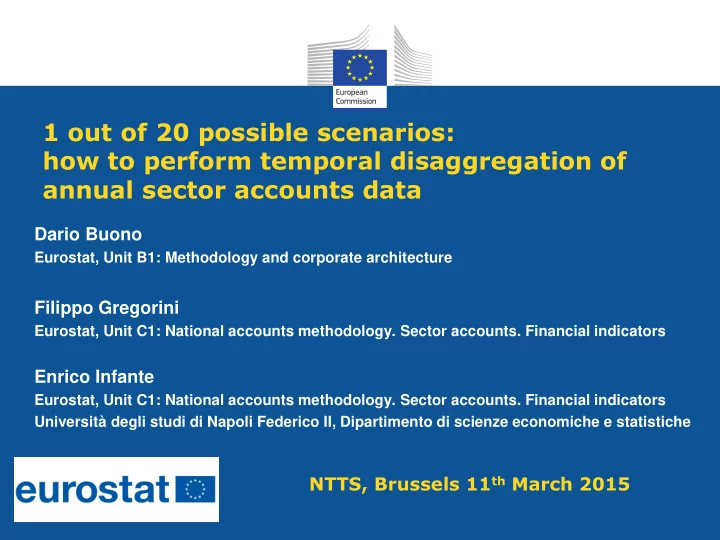

1 out of 20 possible scenarios: how to perform temporal disaggregation of annual sector accounts data Dario Buono Eurostat, Unit B1: Methodology and corporate architecture Filippo Gregorini Eurostat, Unit C1: National accounts methodology. Sector accounts. Financial indicators Enrico Infante Eurostat, Unit C1: National accounts methodology. Sector accounts. Financial indicators Università degli studi di Napoli Federico II, Dipartimento di scienze economiche e statistiche NTTS, Brussels 11 th March 2015
Summary • Introduction • Methods • Results • Conclusions 2 Eurostat
Introduction • Sector accounts data are to be provided by Member States on both annual and quarterly bases • Member States whose contribution to the EU GDP is below 1% ("small") have to provide only a partial matrix for quarterly data • In such cases only annual data are available, but quarterly estimates for "small" countries are needed for the production of quarterly data for the aggregates (EA, EU) • The aim of this paper is to build an empirical application to estimate missing quarterly series for the 5 "small" EU countries to produce EU28 aggregates • The whole exercise is performed with JDemetra+ 2.0.0 3 Eurostat
Methods • Accounting and temporal constraints • Mathematical methods: o Denton (1971) • Regression based methods: o Chow-Lin (1971) – AR(1) Soft Watch at the Moment of First Explosion, Dali (1954) o Fernández (1981) – Random Walk o Litterman (1983) – Random Walk Markov • Many other methods are available, as Di Fonzo and Marini (2012), which takes into account both the two constraints • Timing constraints • The exercise is to be performed during the production round, where the time constraint is really important 4 Eurostat
Which method does what: possible scenarios Naïve Denton Chow-Lin (Fernández, Litterman) Temporal constraint (temporal disaggregation) Wei-Stram X DiFonzo-Marini Accounting constraint Denton modified (benchmarking) Cholette-Dagum-Bee Cholette modified EU28 AGGREGATE 5 Eurostat
Methods Target series: Quarterly EU28 aggregate Quarterly EU28 figures, assuming the missing A 5 countries behave like the other 23 countries Quarterly figures for each of the 5 missing B countries Quarterly figures for the 5 missing countries C aggregated "EU5" 6 Eurostat
Methods Target series: Quarterly EU28 aggregate Quarterly EU28 figures, assuming the missing A 5 countries behave like the other 23 countries Quarterly EU23 data of the same variable 7 Eurostat
Methods Target series: Quarterly EU28 aggregate Quarterly figures for each of the 5 missing B countries Related available quarterly data for each missing county (e.g. GDI) 8 Eurostat
Methods Target series: Quarterly EU28 aggregate Quarterly figures for the 5 missing countries C aggregated "EU5" - Quarterly EU23 data - Seasonal component of EU23 data - Trend and irregular component of EU23 data 9 Eurostat
Results • The series showed here is the compensation of employees paid by non-financial corporations (S11_D1PAY) • For this specific transaction, the weight of the 5 missing countries among the total EU is 2.04%. In general the weight is between 1.5% and 3% • The exercise has been performed by using approach "A" • In the charts only the extrapolated "EU5" figures are presented, in order to better show the differences between the different methods • The Denton and the Chow-Lin approaches are compared with the naïve method (dividing the annual figures by 4) 10 Eurostat
11
12
13
14
Results • Although the differences between Denton and Chow-Lin methods are small, the latter will allow us to look at goodness of fit statistics 15 Eurostat
Conclusions • Our exercise shows that with up-to-date software, different approaches are fast and easily replicable, and therefore useful for production purposes • Chow-Lin (and similar) statistical model is as fast as mathematical models to be displayed but also has the key advantage of being a statistical method, so that its regression analysis enable to measure the goodness of fit of the estimates • JDemetra+ is an user-friendly tool which allows the users to modify the specifications according to specific needs in a quick and easy way 16 Eurostat
Thank you for your attention! Благодаря ви за вниманието! Tack för er uppmärksamhet! Děkuji vám za pozornost! Tak for jeres opmærksomhed! Dank u voor uw aandacht! Tänan tähelepanu eest! Kiitos huomiota! Merci pour votre attention! Vielen Dank für Ihre Aufmerksamkeit! Σας ευχαριστώ για την προσοχή σας ! Köszönöm a figyelmet! Go raibh maith agat as do aird! Grazie per l'attenzione! Paldies par jūsu uzmanību ! Ačiū už Jūsų dėmesį ! Grazzi għall - attenzjoni tiegħek ! Takk for oppmerksomheten! Dziękuję za uwagę ! Obrigado pela vossa atenção! Vă mulţumesc pentru atenţie ! Ďakujem vám za pozornosť ! Hvala za vašo pozornost ! Gracias por su atención! 17 Eurostat
Recommend
More recommend